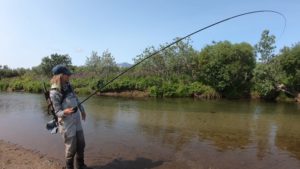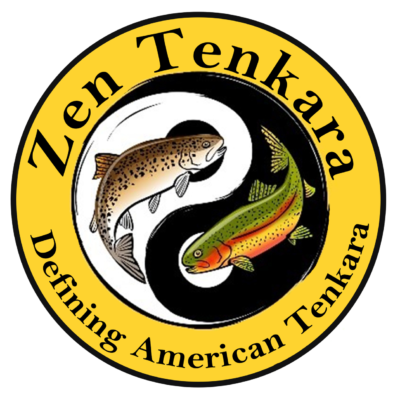
Once you have your tenkara rod, choosing a line is the next decision you have to make. But know you have options and these options are what helps you be prepared for almost anything.
First there are several types of lines so lets quickly review them:
Braided/Furled Line:
These are typically tapered and are also referred to as ‘tapered leaders’. These are to be fished traditionally (meaning kept off the water) using your tenkara triangle. They tend to be heavier which is great for learning the timing of your cast and getting feedback on where and when your tenkara rods loads. Traditional Furled and Tapered Tenkara Lines are great learning tools. Downside is they absorb water and can create splashes when casting (that why you keep them off the water), and they stretch. Getting knots out of these lines can also be difficult.
Note – a high quality line should be tightly woven and not have loose or big spaces between the braids or furls. They should also be made of Uni Thread, and have a tippet ring and dense and tight connection loops which translates into a prolonged line life. These lines are also available in Kevlar which make them even heavier and very good for beginners. Kevlar does not stretch but will absorb water.
Tenkara Level Line:
This is simply colored 100% fluorocarbon. The coloring makes it easier to see on the water. Tenkara anglers use fluorocarbon as line instead of mono because it’s denser and casts easier. These lines come in different thickness with #3.0 and #3.5 being the most popular. The lighter the line, the more finesse it takes to cast it. Tenkara Level Line offers the most delicate presentations and comes on spools so customizing a length is as simple as pulling off the amount of line you want from a spool. Downside is they have a lot of memory and tangle easily. They stretch and they can be difficult to deal with in the wind (sometimes your line and fly get taken away by the wind). Since they are fluorocarbon, tenkara level lines will sink, and pull your fly down if you try to lay these lines on the water to avoid being swept up by the wind. If you’re nymphing this isn’t an issue. Great presentation, annoying to work with.
Floating Lines:
Floating lines can be ultralight proprietary materials, or they can be made from PVC-style fly line. The ultralight versions are designed specifically for tenkara and are just that, ultra delicate, possessing easy connection loops and tippet rings in assorted pre-made lengths. These lines are easy to cast, lighter and more delicate than furled/braided lines, have little memory and no stretch. This is why we love them! Zen Floating Lines even have an 18lb test are hassle-free and are available in 6 lengths. That’s pretty darn good. The PVC-style lines are simply those you can made from cutting apart standard fly lines into desired lengths and tying them onto your tenkara rod. Why would you need to do that? Sometimes in non-traditional tenkara scenarios a heavier line is critical. These scenarios include saltwater applications, high wind conditions, float trip uses when a simple roll cast is best, and when casting big, heavy dish-rag type flies like salmon flies or crawdaddies. Downside to the PVC-style lines is that it takes a little craft work at home and you have to cut up your own fly line and make your own loops (at least until Zen makes their Fusion Tenkara Fly Lines available).
Tenkara Level Line:
This is simply colored 100% fluorocarbon. The coloring makes it easier to see on the water. Tenkara anglers use fluorocarbon as line instead of mono because it’s denser and casts easier. These lines come in different thickness with #3.0 and #3.5 being the most popular. The lighter the line, the more finesse it takes to cast it. Tenkara Level Line offers the most delicate presentations and comes on spools so customizing a length is as simple as pulling off the amount of line you want from a spool. Downside is they have a lot of memory and tangle easily. They stretch and they can be difficult to deal with in the wind (sometimes your line and fly get taken away by the wind). Since they are fluorocarbon, tenkara level lines will sink, and pull your fly down if you try to lay these lines on the water to avoid being swept up by the wind. If you’re nymphing this isn’t an issue. Great presentation, annoying to work with.
Floating Lines:
Floating lines can be ultralight proprietary materials, or they can be made from PVC-style fly line. The ultralight versions are designed specifically for tenkara and are just that, ultra delicate, possessing easy connection loops and tippet rings in assorted pre-made lengths. These lines are easy to cast, lighter and more delicate than furled/braided lines, have little memory and no stretch. This is why we love them! Zen Floating Lines even have an 18lb test are hassle-free and are available in 6 lengths. That’s pretty darn good. The PVC-style lines are simply those you can made from cutting apart standard fly lines into desired lengths and tying them onto your tenkara rod. Why would you need to do that? Sometimes in non-traditional tenkara scenarios a heavier line is critical. These scenarios include saltwater applications, high wind conditions, float trip uses when a simple roll cast is best, and when casting big, heavy dish-rag type flies like salmon flies or crawdaddies. Downside to the PVC-style lines is that it takes a little craft work at home and you have to cut up your own fly line and make your own loops (at least until Zen makes their Fusion Tenkara Fly Lines available).
So, having a few different lines, particularly when you’re fishing unfamiliar water is the best way to be ready for anything you and your tenkara rod are served up.




I only use floating lines, as you know, Karin. The one I bought from you has lasted me for 6 yrs or so. I’m making my own now, and they work phenomenal. Now is a floating line great for all situations? No. I think level line works best for nymphing, euro or otherwise. Furled lines cast great, but they tend to sink after a while. As you said, personal preference is what most use for their fly lines. And yours are some of the best, just a bit pricey for me. Tight lines!!
You’re right Craig, they aren’t inexpensive but as you said, they last…and perform. I use our Floating line with fluorocarbon sinking.tippet to nymph. I love the hi-vis sight indicator built-in section on the line and nymph by feel, without the use of a sight indicator/bobber. Doing this for a season greatly improved my hook set rates. And while I don’t, we have many customers that swear by our Traditional Furled Kevlar line for nymphing. To each his own. Find what you like and use it but don’t get stuck in your box. Still be open to trying new things because sometimes you find something you like better.
You’re right Craig, they aren’t inexpensive but as you said, they last…and perform. I use our Floating line with fluorocarbon sinking.tippet to nymph. I love the hi-vis sight indicator built-in section on the line and nymph by feel, without the use of a sight indicator/bobber. Doing this for a season greatly improved my hook set rates. And while I don’t, we have many customers that swear by our Traditional Furled Kevlar line for nymphing. To each his own. Find what you like and use it but don’t get stuck in your box. Still be open to trying new things because sometimes you find something you like better.
3.5mm fluorocarbon… mmm, not quite.
Japanese line system is line classes not a metric size. (kind of like an equivalent of aftma fly line sizes).
A #3 line is somewhere around 0.30mm thick, you can find great infos about level lines for traditional tenkara, including the charts, on a lot of websites like Discover Tenkara or Japanese websites.
(Pvc lines on a tenkara rod is a westernised practice of tenkara bringing it closer to fly fishing)
Cheers
Frank YES! You are absolutely correct. The mm after the numbers were typos added by an editor who thought they were being helpful, lol! Thank you for catching the error. The mm’s has since been removed. The numbers and explanation are still good to go.